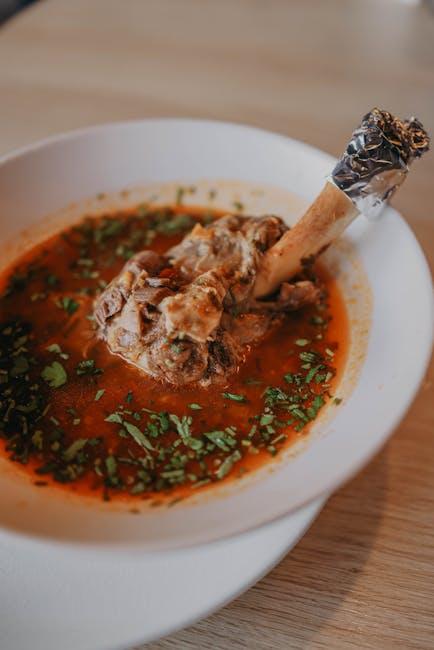In the world of nourishing, gut-friendly foods, few ingredients stand out quite like bone broth. Revered for its rich flavors and rich nutritional profile, bone broth has become a cornerstone in the GAPS diet, celebrated for its healing properties and soothing effects on the digestive system. Whether you’re just beginning your GAPS journey or looking to expand your recipe repertoire, mastering the art of bone broth can unlock a world of wellness and taste. This article delves into the best bone broth recipes tailored specifically for the GAPS diet, blending tradition with creativity to support your gut health and delight your palate.
Table of Contents
- Choosing the Ideal Bones for Nutrient-Rich Broth
- Unlocking the Healing Power of Traditional GAPS Broth
- Incorporating Vegetables and Herbs for Enhanced Flavor
- Step-by-Step Guide to Crafting the Perfect Bone Broth
- Tips for Storing and Using Bone Broth in Your GAPS Diet Meals
- Q&A
- To Conclude

Choosing the Ideal Bones for Nutrient-Rich Broth
To unlock the full nutritional potential of your bone broth, selecting the right bones is essential. Grass-fed beef marrow bones are a top choice, rich in collagen, calcium, and marrow fats that provide deep flavor and an abundance of healing compounds. For poultry enthusiasts, organic chicken feet and wings offer a gelatin-packed base, perfect for achieving that luscious, silky texture vital to gut repair on the GAPS diet. Adding a splash of variety with bones like pork neck bones or veal knuckles can further enhance mineral content and taste complexity, creating a broth that’s both restorative and delicious.
When shopping for bones, prioritize these qualities:
- Freshness: Fresh or properly frozen bones retain more nutrients.
- Source: Look for grass-fed, organic, or pasture-raised animals to avoid hormones and antibiotics.
- Type: A mix of joints, marrow, and meaty bones ensures a rich, balanced broth.
| Bone Type | Main Nutrients | Best For |
|---|---|---|
| Beef Marrow Bones | Collagen, Calcium, Iron | Rich, deep flavor and healing fats |
| Chicken Feet | Gelatin, Glucosamine, Chondroitin | Jelly-like texture & joint support |
| Pork Neck Bones | Collagen, Magnesium, Phosphorus | Nutritious & mild flavor broth |
Unlocking the Healing Power of Traditional GAPS Broth
The essence of traditional GAPS broth lies in its simplicity and profound healing properties. Simmered slowly over several hours, this soothing elixir releases essential minerals and amino acids that support gut repair and immune function. The gelatin-rich broth is not just nourishing but also acts as a natural anti-inflammatory agent, helping to soothe the digestive tract while providing a gentle boost to overall health. For those following the GAPS diet, homemade broth offers a perfect balance of nutrients that are easy to absorb, making it a cornerstone of dietary healing.
To truly harness its power, consider the key ingredients and cooking techniques that distinguish authentic GAPS broth:
- Organic bones: Rich in marrow and collagen, these provide a robust nutritional foundation.
- Vegetables: Simple root vegetables like carrots and onions add flavor and extra vitamins without overwhelming the broth.
- Consistent low simmering: This gradual process maximizes mineral extraction and transforms tough connective tissue into restorative gelatin.
| Key Nutrient | Health Benefit |
|---|---|
| Gelatin | Supports intestinal lining repair |
| Glycine | Enhances detoxification and reduces inflammation |
| Calcium & Magnesium | Essential for bone health and metabolic function |
Incorporating Vegetables and Herbs for Enhanced Flavor
Elevating bone broth to a culinary delight involves more than just simmering bones and water. Integrating fresh vegetables and aromatic herbs not only boosts the nutritional profile but also layers the broth with nuanced, comforting flavors. Root vegetables like carrots, parsnips, and celery add a subtle sweetness and depth, while onions and garlic contribute a foundational umami punch that melds beautifully during the long simmering process. For those following the GAPS diet, prioritizing organic and fresh produce ensures maximum benefit and purity.
Herbs play a pivotal role in flavor enhancement, imparting both fragrance and therapeutic qualities. Classic choices such as thyme, rosemary, and bay leaves complement the rich, meaty notes, while fresh parsley stirred in at the end of cooking adds a bright, refreshing contrast. Below is a quick guide to popular vegetables and herbs to consider for your bone broth:
| Ingredient | Flavor Profile | Benefits |
|---|---|---|
| Carrots | Sweet, earthy | Rich in beta-carotene and antioxidants |
| Celery | Crisp, slightly bitter | Supports digestion and hydration |
| Garlic | Pungent, savory | Immune-boosting and antibacterial |
| Thyme | Herbaceous, slightly minty | Anti-inflammatory and antimicrobial |
| Bay Leaves | Woodsy, subtle bitterness | Aids digestion and adds depth |
| Parsley | Fresh, peppery | Rich in vitamins and enhances taste |
Step-by-Step Guide to Crafting the Perfect Bone Broth
Begin by gathering high-quality bones such as beef marrow bones, chicken carcasses, or fish heads which form the rich foundation of your broth. To extract maximum nutrients and flavor, roast the bones first until they develop a deep golden hue. Next, transfer them to a large pot or a slow cooker and add filtered water, ensuring bones are fully submerged. Incorporate a splash of apple cider vinegar to help break down the collagen and minerals, enhancing the broth’s healing powers. Toss in aromatic vegetables like onions, garlic, and celery, along with herbs such as thyme or bay leaves, but avoid cruciferous vegetables to keep the broth GAPS-friendly.
Simmer gently over low heat for at least 12 hours, preferably up to 24 or even 48 hours for chicken and beef bones respectively, maintaining just a few bubbles on the surface to preserve delicate nutrients. As the broth cooks, a rich gelatinous layer will form—a sign of a perfect, collagen-packed broth. Skim off any foam or impurities as needed to keep it clear. Once done, strain the liquid through a fine mesh sieve and cool it in the fridge until the fat rises to the top. Remove the fat if desired, then store your bone broth in airtight containers for up to 5 days in the refrigerator, or freeze portions for convenient healing meals on the go.
Tips for Storing and Using Bone Broth in Your GAPS Diet Meals
When it comes to preserving the rich nutrients and flavors of your bone broth, proper storage is key. Always cool the broth to room temperature before refrigerating or freezing to maintain its quality. Use airtight containers—glass jars or BPA-free plastic containers work best—to prevent contamination and reduce odor absorption. For easy portioning, freeze bone broth in ice cube trays or silicone molds; this method lets you thaw just the amount needed without waste.
Incorporate bone broth into your GAPS diet meals creatively by keeping a few handy tips in mind:
- Reheat gently: Avoid boiling to preserve beneficial enzymes.
- Enhance flavors: Add fresh herbs or a splash of apple cider vinegar when reheating.
- Layer nutrition: Use bone broth as a base for soups, stews, or even savory sauces.
| Storage Method | Best For | Average Shelf Life |
|---|---|---|
| Refrigeration | Short-term use | 3-5 days |
| Freezing in Containers | Bulk storage | 3-6 months |
| Freezing in Portions | Single meal prep | 3-6 months |
Q&A
Q&A: Best Bone Broth Recipes for the GAPS Diet
Q1: What is the GAPS diet and why is bone broth important in it?
A1: The GAPS diet (Gut and Psychology Syndrome) is a nutritional protocol designed to heal and seal the gut lining. Bone broth plays a leading role here because it’s rich in collagen, amino acids, and minerals—key components that support intestinal repair and reduce inflammation.
Q2: What makes a bone broth recipe suitable for the GAPS diet?
A2: A GAPS-friendly bone broth recipe emphasizes slow cooking bones with nourishing additives like apple cider vinegar (to help extract minerals), vegetables low in starch, and herbs. It avoids processed ingredients, grains, and any additives that may irritate the gut.
Q3: Can you share a simple yet effective bone broth recipe for beginners on the GAPS diet?
A3: Certainly! Start with a few pounds of organic chicken bones, add 2 tablespoons apple cider vinegar and cover with filtered water. Include onions, carrots, celery, garlic, and a handful of fresh herbs like parsley and thyme. Simmer for 12-24 hours, strain, and store. This slow-cooked broth is a warm gut healer and a fantastic base for soups or sipping.
Q4: How can I customize bone broth recipes to suit my taste while staying GAPS-compliant?
A4: Feel free to experiment with different bones—beef, turkey, or fish—and herbs like rosemary or bay leaves. For added gut support, incorporate ginger or turmeric during cooking. Always stick to whole, natural ingredients and avoid any spices or additives that trigger sensitivities.
Q5: How often should I consume bone broth on the GAPS diet?
A5: Many practitioners recommend sipping bone broth daily, especially during the early stages of the diet. Start with small servings—half a cup—to assess tolerance, then increase to 1–2 cups per day as your gut heals.
Q6: Are there particular bones better suited for GAPS bone broth?
A6: Ideally, use varied bones for a richer nutrient profile: joint bones with cartilage for collagen, marrow bones for healthy fats, and neck or knuckle bones for gelatin. Organic, grass-fed, or pasture-raised sources are preferable to maximize health benefits.
Q7: Can bone broth be stored and reheated without losing its benefits?
A7: Yes, bone broth can be refrigerated for up to 5 days or frozen for several months. When reheating, do so gently on low heat to preserve its delicate proteins and nutrients.
Q8: Are there any common mistakes to avoid when making GAPS-compliant bone broth?
A8: Avoid rushing the cooking process; short simmering times don’t extract the full spectrum of nutrients. Also, skip adding starchy vegetables or grains, and don’t discard the gelled broth—it’s a sign of rich collagen content!
Q9: Is bone broth suitable for everyone on the GAPS diet?
A9: Most people on GAPS benefit from bone broth, but those with severe histamine intolerance or specific allergies should consult their healthcare provider before regular consumption.
Q10: How can I integrate bone broth into my daily meals beyond just sipping it?
A10: Bone broth is a versatile culinary ally. Use it as a base for soups, stews, sauces, or even cooking grains and vegetables. Its rich flavor and gut-healing properties enhance many dishes while supporting your GAPS journey.
To Conclude
As you embark on your GAPS journey, these bone broth recipes offer more than just nourishment—they provide a comforting ritual that supports healing from within. Whether simmered slowly over hours or infused with your favorite herbs and spices, each cup is a warm embrace for your gut and your soul. Experiment, savor, and remember: the best bone broth is the one that feels like home to you. Here’s to health, one hearty spoonful at a time.

